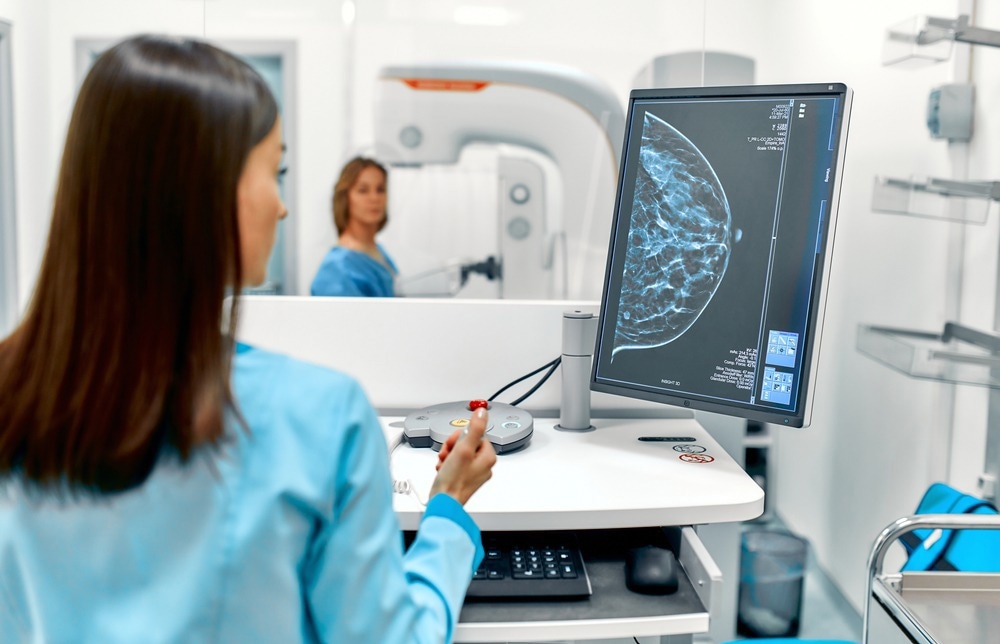The importance of early detection
Benefits of cancer screening
Risks and drawbacks
Cost-effectiveness and accessibility
Ethical considerations
Personalization of screening programs
Policy and recommendations
Conclusion
References
Further reading
The goal of cancer screening is to detect cancer early when the chances of survival are higher compared to discovering the disease after symptoms appear. The prognosis usually depends on the stage at diagnosis 1. While screenings serve as essential tools in this endeavor, it is crucial to acknowledge their limitations and associated risks.

Image Credit: Gorodenkoff/Shutterstock.com
Balancing the benefits and risks of screenings while considering ethical factors and personalizing screening programs based on individual risk factors is essential for maximizing their effectiveness.
The importance of early detection
By altering or eliminating significant risk factors and implementing currently recommended evidence-based preventive measures, between 30% and 50% of cancer-related fatalities could be avoided. Early cancer detection and patient care are additional strategies to reduce the cancer burden. Prevention is also the most economical long-term approach to cancer control 2.
Screenings typically do not identify cancer. Instead, they help the healthcare provider determine if further testing is needed. For instance, a breast lump found during a mammogram does not automatically indicate breast cancer. To determine if the lump is malignant, the patient would require a biopsy or another type of diagnostic procedure 3.
There are a wide variety of screening test options available, including physical examinations (to look for abnormalities or tumors that could indicate a disease), lab tests (using tissue, urine, and blood samples), genetic tests (searching for alterations in your genes associated with certain cancer types), and imaging techniques (such as mammography, which take images of your internal body) 3. Common screenings include mammograms for breast cancer, Pap smears for cervical cancer, and colonoscopies for colorectal cancer 3.
Benefits of cancer screening
When detected early, cancer is more likely to respond to appropriate treatment, increasing the likelihood of survival and resulting in lower treatment costs and morbidity. Two different approaches support early detection: early diagnosis and screening. Early diagnosis aims to identify cancer cases at the earliest possible stage when symptoms are present.
The goal of screening is to find individuals who have abnormalities suggestive of a particular cancer or pre-cancer but do not yet exhibit any symptoms and then quickly refer them for diagnosis and treatment 2.
According to a 2020 study, increasing screening rates to 100% could prevent an additional 2,821 deaths from breast cancer, 6,834 deaths from cervical cancer, and 35,530 deaths from colorectal cancer (CRC) in a single-year cohort. Although twice as many people (both men and women) would need CRC screening compared to breast cancer screening for women only, the increase in CRC screening would prevent almost 8.5 times as many deaths 4.

Image Credit: ORION PRODUCTION/Shutterstock.com
Risks and drawbacks
While cancer screenings offer numerous advantages, it's important to consider the risks. Some screenings, like colon cancer screenings, may lead to future complications such as tears in the colon's lining. Additionally, test results can sometimes be falsely positive, causing unnecessary worry and additional testing.
Conversely, there's also the risk of false-negative results, where cancer may be present despite normal test results, potentially delaying necessary treatment 5. Radiation exposure and overdiagnosis can lead to unnecessary expenses and negative consequences for patients.
Psychological harm can cause many individuals to experience anxiety and tension throughout the screening process. Furthermore, cancer screenings may uncover unrelated medical conditions, necessitating further testing or potentially risky procedures 5.
Cost-effectiveness and accessibility
Racial and socioeconomic disparities significantly influence the accessibility of cancer screening programs. The interaction of various factors, including behavior, biology, genetics, and social determinants of health, can significantly impact health outcomes.
For example, individuals with low incomes, limited health literacy, lengthy travel times to screening or treatment facilities, lack of health insurance, transportation to medical appointments, or paid medical leave are less likely to undergo recommended cancer screening tests or receive care aligned with guidelines compared to those without such barriers 6.
Studies indicate that Black, Hispanic, Asian, and AIAN (American Indian and Alaska Native) communities have lower overall rates of cancer screening compared to White people 7. Individuals with impairments are less likely to undergo cancer screening compared to those without disabilities 8.
Particularly, individuals with impairments, especially those from lower socioeconomic backgrounds, are less likely to undergo regular screening for cervical and breast cancer 9.
According to economic analyses, cancer screening initiatives can sometimes lead to cost savings. A recent systematic analysis found that economic evaluations underestimate incremental cost-effectiveness ratios. Cancer screening programs initially considered cost-effective were no longer deemed so after accounting for medical costs associated with competing hazards 10.
Incorporating the assessment of healthcare costs and losses in quality of life due to competing hazards in life years gained can indeed help overcome practical challenges associated with evaluating the cost-effectiveness of healthcare initiatives. This inclusion can significantly influence the perceived cost-effectiveness of cancer screening programs 10.
Colorectal Cancer Screening Saves Lives
Ethical considerations
The primary ethical issues raised by screening guidelines are centered around honoring patient autonomy and beneficence. A commitment to patient autonomy entails respecting informed consent and individual decision-making, both of which are legally required for government research.
However, honoring patient autonomy goes beyond simply presenting options; it also involves educating patients about the pros and cons of screening and recognizing that different patients may prioritize these factors differently 11.
Clinicians and their associations have a strong incentive to uphold the safety and efficacy of their screening and treatment procedures. However, such claims should be overseen by an impartial third party to ensure that the benefits genuinely outweigh the risks. For example, a leaflet outlining the precise increase in cancer risk associated with a specific number of CT scans should be provided to patients undergoing such scans 11.
Personalization of screening programs
Anything that increases the chance of developing cancer is a cancer risk factor. However, having one or more risk factors doesn't guarantee that a person will develop cancer, as some individuals may still develop cancer even without any known risk factors 12.
Certain screening examinations are recommended for individuals with established cancer risk factors, which encompass personal history of cancer, family history of cancer, specific gene mutations associated with cancer, exposure to carcinogenic substances at work or tobacco smoke, history of an unidentified blood clot, and advancing age. Individuals with a higher risk of cancer may require more frequent or earlier screening than those with lower risk factors 12.
Policy and recommendations
The WHO's best buys recommendation on noncommunicable diseases 13,14 suggests screening for colorectal, breast, and cervical cancers through well-coordinated, superior programs linked to prompt treatment. According to WHO guidelines, routine screening for cervical cancer should commence at the age of thirty for women.
The WHO guideline for screening and treatment of cervical pre-cancer lesions for cervical cancer prevention provides comprehensive recommendations, including the appropriate use of HPV DNA-based tests and cytology, screen-and-treat strategies, and guidance for women living with HIV 15.
Mammography for breast cancer screening is recommended by the WHO only for women aged 50 to 69 in countries with robust healthcare systems. Initiating early diagnostic programs is preferable, particularly in settings with limited resources, weak health systems, and a high proportion of women diagnosed with cancer later in life 16.
Conclusion
In summary, early detection is crucial for reducing cancer-related deaths, and screening programs are vital for achieving this goal.
However, it's important to acknowledge and address the risks and drawbacks associated with screenings, such as potential complications and psychological harm. Additionally, considering the cost-effectiveness and accessibility of screening programs, especially regarding disparities, is essential.
Ethical considerations, including patient autonomy and informed consent, should guide screening practices. Personalizing screening based on individual risk factors can improve effectiveness.
Lastly, following WHO recommendations and implementing evidence-based screening programs are key to maximizing the impact of early detection efforts in the fight against cancer.
References
- Marcus PM. Assessment of cancer screening: a primer [Internet]. Bethesda (MD): National Cancer Institute (US); 2019 Nov. Chapter 5, Population measures: cancer screening's impact. Available from: https://www.ncbi.nlm.nih.gov/books/NBK550216/
- Cancer: Screening. [Online]. World Health Organization. Available at: https://www.who.int/cancer/prevention/diagnosis-screening/screening/en/ [Cancer Screenings: Understanding the Pros and Cons.[Online]. Pfizer. Available at: https://www.pfizer.com/news/articles/cancer_screenings_understanding_the_pros_and_cons
- Sharma, K. P., Grosse, S. D., Maciosek, M. V., Joseph, D., Roy, K., Richardson, L. C., & Jaffe, H. (2020). Preventing Breast, Cervical, and Colorectal Cancer Deaths: Assessing the Impact of Increased Screening. Preventing chronic disease, 17, E123. https://doi.org/10.5888/pcd17.200039
- Cancer Screening Guidelines Often Lack Information on Potential Harms, Study Finds. [Online]. NIH – National Cancer Institute. Available at: https://www.cancer.gov/news-events/cancer-currents-blog/2022/cancer-screening-guidelines-lack-harms
- Cancer Disparities. [Online]. NIH – National Cancer Institute. Available at: https://www.cancer.gov/about-cancer/understanding/disparities#
- Liu, D., Schuchard, H., Burston, B., Yamashita, T., & Albert, S. (2021). Interventions to Reduce Healthcare Disparities in Cancer Screening Among Minority Adults: a Systematic Review. Journal of racial and ethnic health disparities, 8(1), 107–126. https://doi.org/10.1007/s40615-020-00763-1
- Chevarley, F. M., Thierry, J. M., Gill, C. J., Ryerson, A. B., & Nosek, M. A. (2006). Health, preventive health care, and health care access among women with disabilities in the 1994-1995 National Health Interview Survey, Supplement on Disability. Women's health issues : official publication of the Jacobs Institute of Women's Health, 16(6), 297–312. https://doi.org/10.1016/j.whi.2006.10.002
- Iezzoni, L. I., Kurtz, S. G., & Rao, S. R. (2015). Trends in mammography over time for women with and without chronic disability. Journal of women's health (2002), 24(7), 593–601. https://doi.org/10.1089/jwh.2014.5181
- Ratushnyak, S., Hoogendoorn, M., & van Baal, P. H. M. (2019). Cost-Effectiveness of Cancer Screening: Health and Costs in Life Years Gained. American journal of preventive medicine, 57(6), 792–799. https://doi.org/10.1016/j.amepre.2019.07.027
- Plutynski A. (2012). Ethical issues in cancer screening and prevention. The Journal of medicine and philosophy, 37(3), 310–323. https://doi.org/10.1093/jmp/jhs017
- Cancer Screening Overview (PDQ®)–Patient Version. [Online]. NIH – National Cancer Institute. Available at: https://www.cancer.gov/about-cancer/screening/patient-screening-overview
- Tackling NCDs. 'Best buys' and other recommended interventions for the prevention and control of noncommunicable diseases. Geneva: World Health Organization; 2017. [Online]. Available at: WHO/NMH/NVI/17.9;https://apps.who.int/iris/handle/10665/259232.
- 'Best buys' and other recommended interventions for the prevention and control of noncommunicable diseases. Updated (2017) Appendix 3 of the Global Action Plan 2013–2020. Geneva: World Health Organization; 2020 (https://www.who.int/ncds/management/WHO_ Appendix_BestBuys.pdf).
- WHO guideline for screening and treatment of cervical pre-cancer lesions for cervical cancer prevention, second edition. Geneva: World Health Organization; 2021. [Online]. Available at: https://apps.who.int/iris/ handle/10665/342365.
- WHO position paper on mammography screening. Geneva: World Health Organization; 2014. [Online]. Available at: https://apps.who.int/iris/handle/10665/137339.
Further Reading
Last Updated: Jun 12, 2024